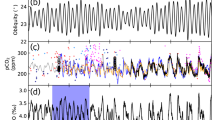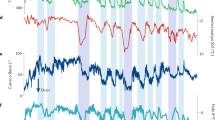Abstract
Milankovitch’s astronomical theory of glacial cycles, attributing ice age climate oscillations to orbital changes in Northern-Hemisphere insolation, is challenged by the paleoclimatic record. The climatic response to the variations in insolation is far from trivial. In general the glacial cycles are highly asymmetric in time, with slow cooling from the interglacials to the glacials (inceptions) and very rapid warming from the glacials to the interglacials (terminations). We shall refer to this fast-slow dynamics as the “saw-tooth” shape of the paleoclimatic record. This is non-linearly related to the time-symmetric variations in the orbital forcing. However, the most pronounced challenge to the Milankovitch theory is the middle Pleistocene transition (MPT) occurring about one million years ago. During that event, the prevailing 41 kyr glacial cycles, corresponding to the almost harmonic obliquity cycle were replaced by longer saw-tooth shaped cycles with a time-scale around 100 kyr. The MPT must have been driven by internal changes in climate response, since it does not correspond to any apparent changes in the orbital forcing. In order to identify possible mechanisms causing the observed changes in glacial dynamics, it is relevant to study simplified models with the capability of generating temporal behavior similar to the observed records. We present a simple oscillator type model approach, with two variables, a temperature anomaly and a climatic memory term. The generalization of the ice albedo feedback is included in terms of an effective multiplicative coupling between this latter climatic memory term (representing the internal degrees of freedom) and the external drive. The simple model reproduces the temporal asymmetry of the late Pleistocene glacial cycles and suggests that the MPT can be explained as a regime shift, aided by climatic noise, from a period 1 frequency locking to the obliquity cycle to a period 2–3 frequency locking to the same obliquity cycle. The change in dynamics has been suggested to be a result of a slow gradual decrease in atmospheric greenhouse gas concentration. The critical dependence on initial conditions in the (non-autonomous) glacial dynamics raises fundamental questions about climate predictability.








Similar content being viewed by others
References
Ashkenazy Y, Tziperman E (2004) Are the 41 kyr oscillations a linear response to Milankovitch forcing? Quat Sci Rev 23:1879–1890
Augustin L, Barbante C, Barnes PR et al (2004) Eight glacial cycles from an Antarctic ice core. Nature 429:623–628
Benzi R, Parisi G, Sutera A, Vulpiani A (1982) Stochastic resonance in climatic change. Tellus 34:10–16
Berger AL (1978) Long-term variations of daily insolation and quaternary climatic changes. J Atmos Sci 35:2362–2367
Berger A (1988) Milankovitch theory and climate. Rev Geophys 26:624–657
Berger A (2012) A brief history of the astronomical theories of paleoclimates. In: Berger A et al (eds) Climate change. Springer, Wien, pp 107–129
Berger A, Loutre MF (1991) Insolation values for the climate of the last 10 million of years. Quat Sci Rev 10:297–317
Budyko MI (1969) The effect of solar radiation changes on the climate of the Earth. Tellus 21:611–619
Chekroun MD, Simonnet E, Ghil M (2011) Stochastic climate dynamics: random attractors and time-dependent invariant measures. Phys D 240(21):1685–1700
Clark PU, Archer D, Pollard D, Blum JD, Rial JA, Brovkin V, Mix AC, Pisias NG, Roy M (2006) The middle Pleistocene transition: characteristics, mechanisms, and implications for long-term changes in athmospheric pCO2. Quat Sci Rev 25:3150–3184
Clark PU, Pollard D (1998) Origin of the middle Pleistocene transition by ice sheet erosion of regolith. Paleoceanography 13:1–9
Crucifix M (2012) Oscillators and relaxation phenomena in Pleistocene climate theory. Philos Trans R Soc A 370:1140–1165
Crucifix M (2013) Why could ice ages be unpredictable? Clim Past 9:2253–2267
De Saedeleer B, Crucifix M, Wieczorek S (2013) Is the astronomical forcing a reliable and unique pacemaker for climate? A conceptual model study. Clim Dyn 40:273–294
Ditlevsen PD (2009) Bifurcation structure and noise-assisted transitions in the Pleistocene glacial cycles. Paleoceanography 24:PA3204
Hays JD, Imbrie J, Shackleton NJ (1976) Variations in the Earth’s orbit: pacemaker of the ice ages. Science 194:1121–1132
Hoffman PF, Kaufman AJ, Halverson GP, Schrag DP (1998) A Neoproterozoic snowball Earth. Science 281:1342–1346
Huybers P (2006) Early Pleistocene glacial cycles and the integrated summer insolation forcing. Science 313:508–511
Huybers P (2007) Glacial variability over the last two million years: an extended depth-derived age model, continuous obliquity pacing, and the Pleistocene progression. Quat Sci Rev 26:37–55
Huybers P (2009) Pleistocene glacial variability as a chaotic response to obliquity forcing. Clim Past 5:481–488
Huybers P, Wunsch C (2005) Obliquity pacing of the late Pleistocene glacial terminations. Nature 434:491–494
Hyde WT, Peltier WR (1985) Sensitivity experiments with a model of the ice age cycle: the response to harmonic forcing. J Atmos Sci 42:2170–2188
Imbrie J, Berger A, Boyle EA, Clemens SC, Duffy A, Howard WR, Kukla G, Kutzbach J, Martinson DG, McIntyre A, Mix AC, Molfino B, Morley JJ, Peterson LC, Pisias NG, Prell WL, Raymo ME, Shackleton NJ, Toggweiler JR (1993) On the structure and origin of major glaciation cycles 2. The 100,000-year cycle. Paleoceanography 8:699–735
Imbrie JZ, Imbrie-Moore A, Lisiecki LE (2011) A phase-space model for Pleistocene ice volume. Earth Planet Sci Lett 307(94):102
Kallen E, Crafoord C, Ghil M (1979) Free oscillations in a climate model with ice-sheet dynamics. J Atmos Sci 36:2292–2303
LeTreut H, Ghil M (1983) Orbital forcing, climate interactions, and glacial cycles. J Geophys Res 88:5167–5190
Lisiecki LE, Raymo ME (2005) A Pliocene–Pleistocene stack of 57 globally distributed benthic D18O records. Paleoceanography 20:PA1003
Paillard D (1998) The timing of Pleistocene glaciations from a simple multiple-state climate model. Nature 391:378–381
Paillard D, Parrenin F (2004) The Antarctic ice sheet and the triggering of deglaciations. Earth Planet Sci Lett 227:263–271
Petit JR et al (2001) Vostok ice core data for 420,000 years, IGBP PAGES/World Data Center for Paleoclimatology data contribution series no. 2001–076. NOAA/NGDC Paleoclimatology Program, Boulder CO, USA
Rial JA (2004) Abrupt climate change: chaos and order at orbital and millennial scales. Glob Planet Change 41:95–109
Saltzman B, Maasch K (1991) A first-order global model of late Cenozoic climate change II: a simplification of CO2 dynamics. Clim Dyn 5:201–210
Sellers WD (1969) A climate model based on the energy balance of the earth–athmosphere system. J Appl Meteorol 8:392–400
Shackleton NJ (1997) Deep-sea sediment record and the Pliocene–Pleistocene boundary. Quart Int 40:33–35
Tziperman E, Gildor H (2003) On the mid-Pleistocene transition to 100-kyr glacial cycles and the asymmetry between glaciation and deglaciation times. Paleoceanography 18:1–8
Tziperman E, Raymo ME, Huybers P, Wunsch C (2006) Consequences of pacing the Pleistocene 100 kyr ice ages by nonlinear phase locking to Milankovitch forcing. Paleoceanography 21:PA4206
Acknowledgments
I. D. acknowledges the support of the Hungarian Science Foundation under the contract OTKA NK72037 and that of the Hungarian Meteorological Service. We thank Michel Crucifix and one anonymous reviewer for constructive comments.
Author information
Authors and Affiliations
Corresponding author
Rights and permissions
About this article
Cite this article
Daruka, I., Ditlevsen, P.D. A conceptual model for glacial cycles and the middle Pleistocene transition. Clim Dyn 46, 29–40 (2016). https://doi.org/10.1007/s00382-015-2564-7
Received:
Accepted:
Published:
Issue Date:
DOI: https://doi.org/10.1007/s00382-015-2564-7




